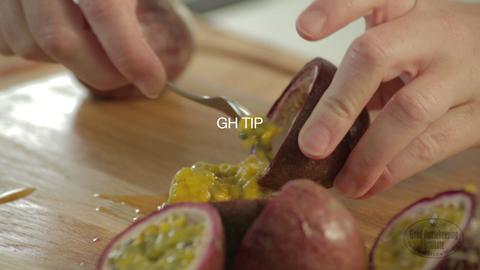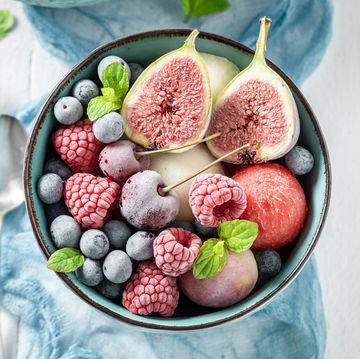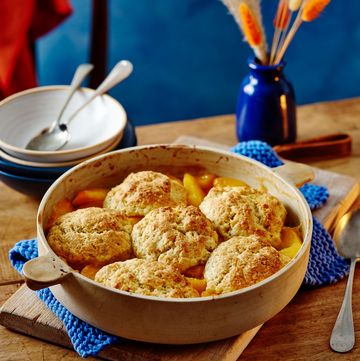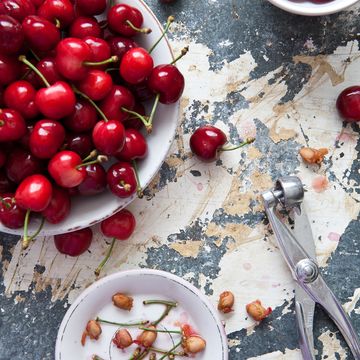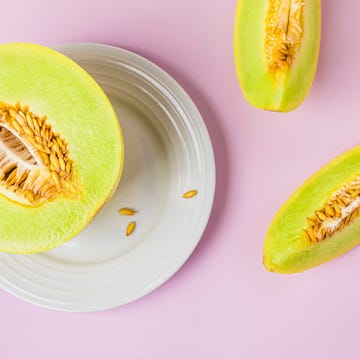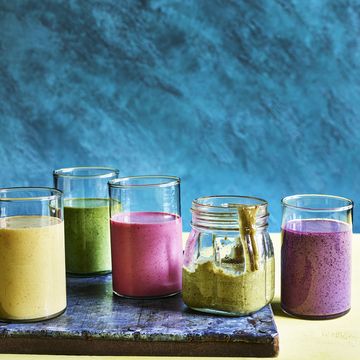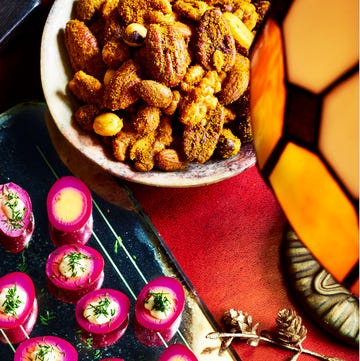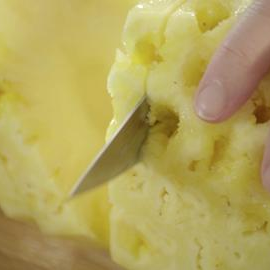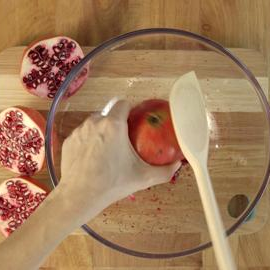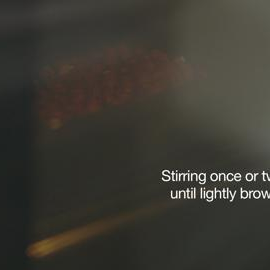1. To prepare passionfruit, cut fruit in half with a sharp knife and scoop out the edible seeds and juicy flesh that surrounding them.
2. If a recipe calls for no seeds, scoop into a sieve held over a bowl. Push the seeds against sieve with a spatula or back of a wooden spoon, to extract all the juice and flesh.
When selecting passionfruit in the shop, look for ones that are plump and feel heavy for their size. Signs of blemishes like scratches or marks are entirely acceptable, as they do not affect the flavour of the fruit inside. Avoid green passionfruit, as the colour indicates it is not ripe enough. Look for fruit with a solid purple, red or yellow colour, along with slightly wrinkled skin.
It is a good idea to always wash the fruit before cutting into it, and whole ripe passionfruit can last for up to 2 weeks if stored in the crisper drawer of the refrigerator. Passionfruit pulp freezes well, so if you manage to get hold of a glut in the height of summer, simply use an ice-cube tray to create portions for use later.
To eat passionfruit raw, cut it in half and scoop out the pulp and seeds using a spoon. You can eat both the seeds and pulp; however, the rind is not edible and very bitter.
Cher Loh, Head Tutor at the Good Housekeeping Institute Cookery School, offers some tips on how to use it: 'Passionfruit is such a versatile fruit, and works well in both savoury and sweet dishes. Try swirling them through an Eton mess or any dessert, or use as a topping on your breakfast yogurt. The seeds are edible along with the surrounding juicy pulp, and they add a superb texture and crunch to salads and dressings. The juice is also great for use in cocktails and cordials.'
'For more adventurous cooks, try using passionfruit juice (in place of lemon juice) to make curd or jam, and fold it through some whipped double cream to use as filling or icing in cakes or eclairs. Or you could spoon a decadent dollop of passionfruit curd on a shortbread - the perfect zingy pick-me-up treat between Zoom meetings.'
- Cher runs regular cookery classes at the Good Housekeeping Institute Cookery School. Classes cover a broad range of topics from kitchen skills to world cuisines and are designed for a variety of ages and abilities. For more information, or to purchase gift vouchers, head to the cookery school page.
Use your skills to make these triple-tested recipes:
Passionfruit, grape and banana smoothie recipe
Copacabana fruit salad recipe
Or, use passion fruit seeds to top these Tutti fruity sorbets
Pro chef's knife, Loft 24 piece dinner set, Zwilling J.A. Henckels. Black two-tone silicone scraper, Kuhn Rikon UK. Classic glass bowl (0.5 litres), Pyrex. Soft-grip sieve (18cm), Lakeland. Pink-sided chopping board, chef's own.
An experienced and highly skilled team of food writers, stylists and digital content producers, the Good Housekeeping Cookery Team is a close-knit squad of food obsessives. Cookery Editor Emma Franklin is our resident chilli obsessive and barbecue expert, who spends an inordinate amount of time on holidays poking round the local supermarkets seeking out new and exciting foods. Senior Cookery Writer Alice Shields is a former pastry chef and baking fanatic who loves making bread and would have peanut butter with everything if she could. Her favourite carb is pasta, and our vibrant green spaghetti is her weeknight go-to. Lover of all things savoury, Senior Cookery Writer Grace Evans can be found eating crispy corn and nocellara olives at every opportunity, and will take the cheeseboard over dessert any time (though she cannot resist a slice of tres leches cake). With a wealth of professional kitchen know-how, culinary training and years of experience between them, they are all dedicated to ensuring every Good Housekeeping recipe is the best it can be, so you can trust they’ll work (and if they don’t – we’ll have the answer for why*) every time (*90% of the time the answer is: “buy an separate oven thermometer”!).
